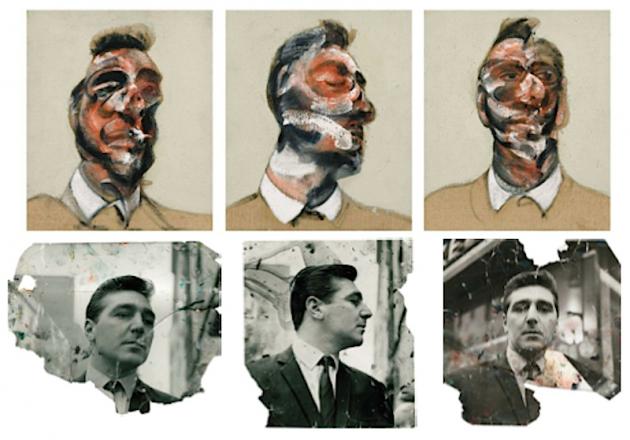Three Studies for Portrait of George Dyer (on light ground) by Francis Bacon is to go under the hammer in Sotheby’s Evening sale of Contemporary Art in London . The painting depicts the man who was the love of Bacon’s life at the moment when they were most deeply involved, this exceptionally rare lifetime depiction of Dyer is full of the painterly exuberance that marks out Bacon as one of the greatest painters of the 20th century. An outstanding example of Bacon at the height of his powers, this museum- quality work is also of critical importance because it is, in all likelihood, the first painting for which Bacon used the legendary photographs by his friend John Deakin as source material for a painting. An outstanding example of Bacon at the height of his powers, this exceptional work has only rarely been seen in public. Having remained in the same collection since 1970, it now comes to auction for the first time ever with an estimate of £15-20 million.
Oliver Barker, Sotheby’s Senior International Specialist in Contemporary Art, said: “Painted less than a year after their first encounter, Three Studies for Portrait of George Dyer marks both the height of Bacon’s affair with Dyer and the zenith of his achievement in portraiture. Full of the painterliness, chaotic brushstrokes and raw emotion that make Bacon such a giant among artists, we expect it to create great excitement at auction, coming at a moment when the market for works by Bacon is at an all-time high.”
Three Studies for Portrait of George Dyer is a rare type of eulogy to Dyer, not least because Bacon destroyed any canvas that he deemed unsatisfactory. Indeed, despite 129 photographs of Dyer being found in Bacon’s studio after the artist’s death, this painting is one of only five known triptychs of Dyer in this small scale, intimate format that Bacon reserved for what are widely regarded as the most profoundly personal and intense portraits of the 20th century. It also serves as a counterpoint to the so-called ‘Black Triptychs’ of the early 1970s that commemorate Dyer and which are often deemed to be the pinnacle of Bacon’s whole oeuvre.
According to popular myth, Bacon famously ‘met’ Dyer when he caught him breaking into his home one night in 1963. The two fell immediately – and passionately – in love, and from that moment on Dyer featured large both in Bacon’s life and in his art. Hailing from the East End of London, Dyer had received little formal education, possessed a criminal record and had served several short prison terms for theft and petty crime. Nevertheless, well-built and immaculately dressed, he soon succeeded Peter Lacy, who had died the previous year, as Bacon’s companion and lover. As the 1960s advanced, Bacon and Dyer’s affair became increasingly stormy. The artist repeatedly bought Dyer out of trouble and by providing a ‘kept’ existence, inadvertently fuelled the East Ender’s increasing paranoia and lack of purpose, which in turn drove his worsening drink problem and depression. In the Autumn of 1971 the pair travelled to Paris for the major retrospective of Bacon’s work that had been organised at the Grand Palais. It was to be a monumental occasion celebrating the artist’s already stellar career. However, barely 36 hours before the opening, George Dyer was found dead from an overdose of sleeping pills, exacerbated by alcohol abuse, in the hotel suite the pair shared. Dyer’s suicide left Bacon grief-stricken. Haunted by his loss, Bacon continued to paint Dyer for some years, producing the famous ‘Black Triptychs’ of the early 1970s.
Thus, both before and after death, George Dyer provided a defining inspiration for Bacon’s work, proving the catalyst for a string of masterworks. Just as Pablo Picasso created a profile of his young lover Marie-Thérèse Walter and obsessively repeated it in works throughout the 1930s, Bacon created a distinctive and instantly recognisable template for the outline of George Dyer’s head which became a highly visible recurrence in his 1960s and ‘70s output.
This triptych is also of immense significance because here, apparently for the first time, we see Bacon using the legendary photographs taken by his friend old John Deakin as the basis for a painted image. In early 1964, just months after he first met Dyer, Bacon commissioned Deakin – a former Vogue staff photographer and one of Bacon’s Soho drinking buddies – to take photographs of Dyer and other fellow habitués of Soho’s Colony Room. These photographs were to have a huge influence on Bacon’s portraits from then on. Although Bacon had painted Dyer at least once before, it is in this triptych that we see for the first time, in painted form, the readily identifiable features, as captured in Deakin’s photographs.
Bacon rarely painted from live models. Talking of his subjects, Bacon said: “If I know them and have photographs of them, I find it easier to work than actually having their presence in the room. I think that, if I have the presence of the images there, I am not able to drift so freely as I am able to through the photographic image. This may just be my own neurotic sense but I find it less inhibiting to work from them through memory and their photographs than actually having them seated there before me.” (the artist cited in: David Sylvester, Interviews with Francis Bacon, London 1993, p.48).
With its exuberance of arcs and dashing flecks of paint, Bacon’s triptych is a far remove from the original photographic image from which he worked. Not seen in London for over 20 years, Three Studies for Portrait of George Dyer (on Light Ground) will be exhibited in Sotheby’s London galleries from Friday 27th until noon on Monday 30th June, prior to its sale on the evening of the 30th.

